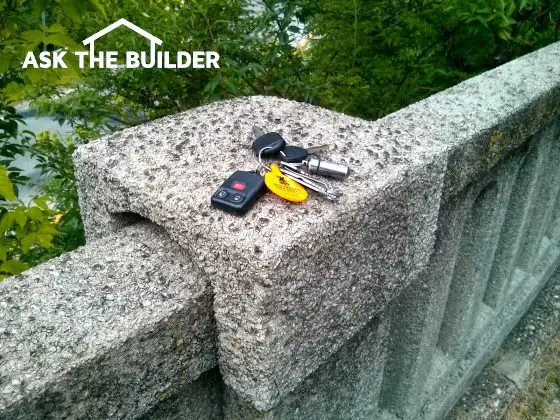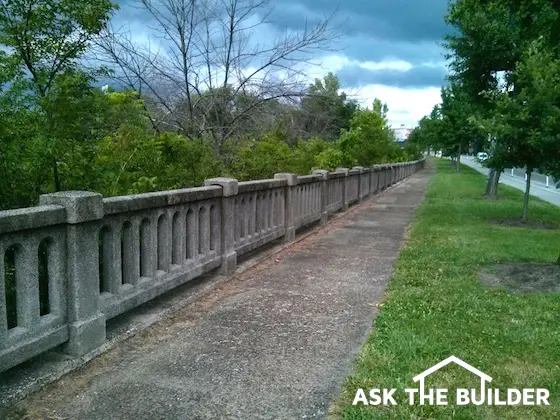How Long Can Concrete Last

How Long Can Concrete Last | This is a cast concrete guardrail in Cincinnati, OH that’s just under 100 years old. It’s in excellent shape other than the cement paste has worn off revealing the small aggregate stone chips. Copyright 2021 Tim Carter
How Long Can Concrete Last - Over a Hundred Years!
You may be holed up in your home as I am. Lately, I’ve been spending some time looking at the thousands of photographs I’ve shot over the past few years. When I travel and see something interesting about construction, building, or historic value, I always try to capture it in a photograph or short video.
Three years ago I made a trip back to my hometown, Cincinnati, Ohio. When I go back, I often drive the roads I walked along or peered out the rear windows of my mom and dad’s 1959 Chevy station wagon as they drove around. On this particular trip, I found myself on Central Parkway, a magnificent roadway built on a gravel outwash terrace created as the last continental glacier melted about 13,000 years ago.
Cast Concrete For Cincinnati Subway
What caught my eye was the stunning guardrail that rests atop a hidden subway tunnel that runs under Central Parkway for miles. Back in the early 1900s, the leaders of Cincinnati thought it would be a wonderful idea to have a mass transit subway. They floated a bond issue and got ready to go, but World War I, the passage of the Prohibition Amendment, and the great stock market crash submarined the project. Timing is everything, isn’t it?
By the time they started construction of this magnificent public works project, it was late January 1920. The shortage of building materials and other things caused the cost to double. The bottom line is the project ran out of money and what’s left are miles and miles of abandoned tunnels under Central Parkway stretching all the way back to downtown Cincinnati. I used to play in the first 150 feet of these tunnels back in the early 1960s. At Dixmyth Avenue just below my house, there were open entrances into the subway. I’d walk in until the fading light sapped my courage to go any further.
Modular Cast Concrete Guardrail
I share this with you because the architects of the project specified stunning modular cast concrete guardrails along stretches of the subway where one side of the tunnel was facing west.

This cast concrete railing was built in 1925. It's along Central Parkway in Cincinnati, Ohio just north of the end of the Western Hills Viaduct. The photo was taken in 2017. The sidewalk next to the railing was poured in the mid-1920s as well. A major roadway is on the other side of the grass strip. Read below why the railing and sidewalk are still in great shape. Copyright 2021 Tim Carter
Here it is one hundred years later and the guardrails are in almost perfect condition having survived brutal cold weather, decades of salt spray from winter snow and ice control on the parkway, and punishing hot weather that might pulverize the concrete from expansion.
Old Concrete Railroad Bridge Abutments
You may have concrete like the Cincinnati subway guardrails in your city or town. All you have to do is pay attention where old railroad bridges with concrete abutments cross roadways or hiking trails. It was common for the builders to cast in the date the bridge was built. You’ll commonly find concrete bridge abutments with dates in the early 1900s.
Other than the cement-paste coating wearing away, the concrete in the guardrail I admired and the bridges you might see is in excellent condition. Why is this so? Why did this concrete survive yet your driveway, sidewalk, patio, etc. crack, spall, dust or otherwise look horrible after five, ten or twenty years?
What Can You Do To Make Concrete Last?
The answer is simple. The architects that designed these projects specified stronger concrete than what your contractor is most likely using. In addition, the concrete was carefully mixed, cast, and cured so it would attain the maximum design strength.
What Holds Concrete Together?
Stop for a moment and think about concrete in its most basic form. It has only four ingredients: rocks, sand, Portland cement, and water. If you leave out the Portland cement you get what you see at the beach. Sand and stones mixed with water that you can shovel with minimal effort.
Add Portland cement and you create artificial rock. The cement is the glue that bonds the sand and stones together. The more cement you add, the stronger the concrete becomes. I don’t have access to the original specifications for the subway guardrails or the railroad bridges, but if I had to guess, I’d say the designers called out for concrete that might test out with a compressive strength of 7,000 pounds per square inch (PSI) or more.
When you add more cement to the mix, you simply make the concrete stronger. You may get arguments from concrete scholars who say that adding too much cement to a mix can cause issues. Well of course it can! It's like adding three cups of salt to one quart of soup, silly!
You can easily create concrete that far exceeds the current MINIMUM specification of 4,000 PSI for exterior concrete. I received an email after this column ran nationally from one of my newsletter subscribers. He told me that he was working on a project where they had to take a core sample from a large concrete dam. The dam was decades old and in great shape. It tested out at over 11,000 PSI!
Can Water Hurt Concrete?
But there’s more to it than that. Water is both a friend and foe to making concrete. You need the water to activate the Portland cement, but if you add too much water, you dilute the cement within the mix and the concrete doesn’t perform well or achieve its intended design strength.
Should Concrete Be Cured?
Once you pour or cast the concrete, you need to ensure the water used to mix the concrete doesn’t evaporate too fast. The chemical reaction that transforms the plastic concrete from a mix like baked beans into a solid artificial rock continues for months and months. The water inside the concrete needs to stay there to fuel this reaction that makes the concrete get stronger and stronger. You achieve this by curing the concrete. You can keep it wet or apply a spray-on membrane that stops water from leaving the mass.
Years ago, the builders understood all this. There were master builders, journeymen, and apprentices on the job. It took years for knowledge to build up in a workman’s brain. This system of knowledge transfer has been abandoned for the most part in the residential field of construction, the place where you depend upon it most for work around your home.
Is Concrete a Complex Material?
Yes, concrete is very complex. There are wise scientists who spend their entire career studying it. The Portland Cement Association and American Concrete Institute are but two organizations dedicated to creating long-lasting concrete. I suggest they get in touch with the Cincinnati Public Works Department and see about getting a core-sample test done of the Central Parkway Subway guardrail. Let's see what those engineers specified all those years ago!
Column 1391
One Response to How Long Can Concrete Last